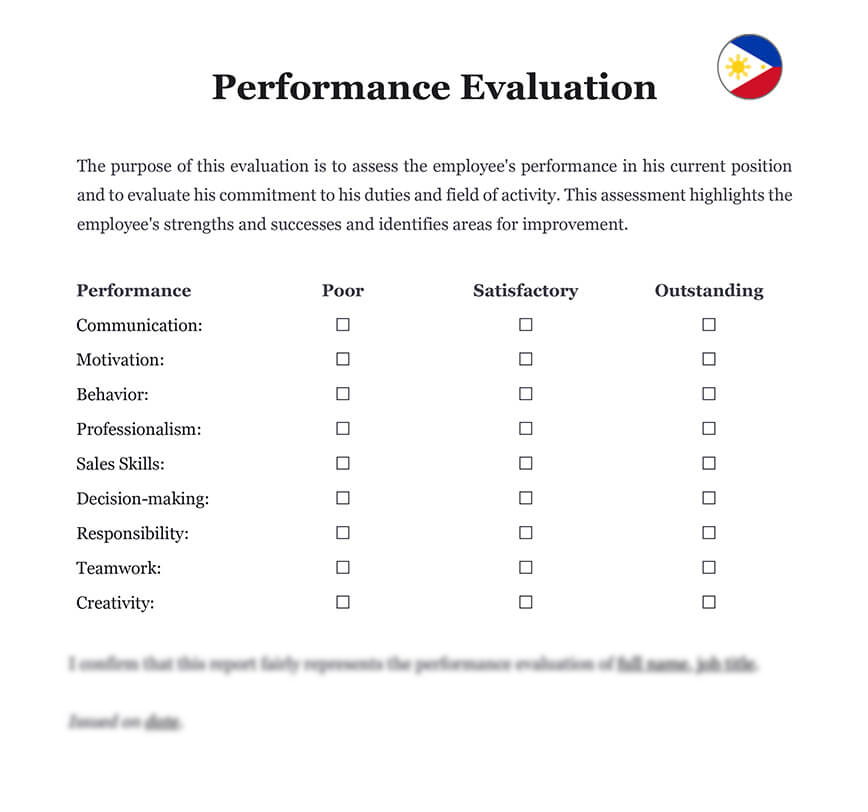Ready to use legal template
Work on without any hassle
Compliant with Filipino law
Ready to use legal template
Work on without any hassle
Compliant with Filipino law
Learn more about Employee Performance Evaluation in Philippines
Employee Performance Evaluation is important in the Philippines for several reasons. It helps employers to identify and recognize the contributions of their employees, which can boost morale and motivation. It also allows employers to provide feedback and coaching to employees, helping them to improve their skills and knowledge. In addition, performance evaluations can help to identify areas for training and development, which can improve employee performance and job satisfaction. Finally, performance evaluations can help to identify employees who may be underperforming, which can help employers to take appropriate corrective action, such as training, coaching, or discipline, to improve performance and avoid legal disputes. Employee Evaluation Performance can be accompanied by an Employee Warning Letter if the results are not satisfactory.
Table of contents
-
What is an Employee Performance Evaluation?
-
What is the importance of Employee Performance Evaluation?
-
What are the key performance indicators for Filipino Employees?
-
How to conduct an employee performance review?
-
What are the Performance Evaluation Methods for Philippine Companies?
-
What are the challenges and solutions in Performance Appraisals?
-
What are the legal considerations in Employee Performance Evaluation in the Philippines?
What is an Employee Performance Evaluation?
An Employee Performance Evaluation in the Philippines is a formal process that assesses an employee’s job performance, accomplishments, strengths, and areas for improvement. It is a tool used by employers to evaluate and provide feedback on the performance of their employees.
The Employee Performance Evaluation typically includes a review of the employee’s job responsibilities, goals, and objectives. The employer will assess the employee’s performance against these factors and provide feedback on areas where the employee is excelling and areas where they need to improve. The performance evaluation may also include a discussion of the employee’s professional development and career goals.
What is the importance of Employee Performance Evaluation?
Employee Performance Evaluation is a critical process that plays an important role in the success of any organization. Here are some key reasons why Employee Performance Evaluation is important:
1. Identifies areas for improvement: Performance evaluation allows employers to identify areas where employees need improvement, and provide training and support to help them develop their skills.
2. Encourages accountability: Employee Performance Evaluation helps employees to understand their responsibilities and accountability. It provides clarity about what is expected of them, which can motivate them to take ownership of their work and strive to do better.
3. Supports career development: Performance evaluation helps identify opportunities for employee career development. Employers can identify high-performing employees and provide them with opportunities for growth and advancement within the organization.
4. Helps with succession planning: Performance evaluation can help identify potential candidates for promotion and support succession planning within the organization.
What are the key performance indicators for Filipino Employees?
The key performance indicators (KPIs) for Filipino employees can vary depending on the nature of the work and the industry. However, here are some common KPIs that employers may use to evaluate the performance of their Filipino employees:
| ➤ Quality of work: This KPI assesses the quality of work that an employee produces. Employers may use various methods to evaluate quality, such as examining error rates, customer satisfaction ratings, or performance against established quality standards. |
| ➤ Productivity: This KPI measures the amount of work that an employee produces within a specified time frame. It may involve tracking the number of tasks completed, output volume, or other metrics. |
| ➤ Attendance and punctuality: Attendance and punctuality are essential KPIs for Filipino employees. Employers may track the number of days absent or late, as this can impact productivity and team performance. |
| ➤ Communication skills: Communication skills are important for all employees, regardless of the industry. Employers may evaluate communication skills by assessing an employee's ability to convey ideas, provide feedback, or communicate with customers or colleagues. |
| ➤ Teamwork and collaboration: Teamwork and collaboration are crucial for many industries. Employers may evaluate an employee's ability to work well with others, contribute to team goals, or resolve conflicts. |
| ➤ Sales or revenue targets: For sales and revenue-focused roles, KPIs may include meeting sales targets or generating revenue within a specified time frame. |
| ➤ Time management: Employers may evaluate an employee's ability to manage their time effectively, prioritize tasks, and meet deadlines. |
| ➤ Professional development: Professional development is essential for employee growth and career advancement. Employers may evaluate an employee's willingness to learn new skills and take on new challenges. |




